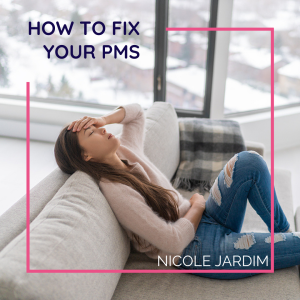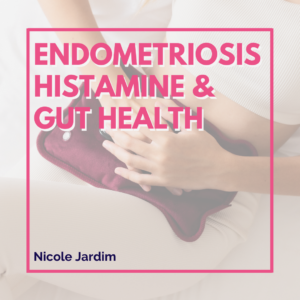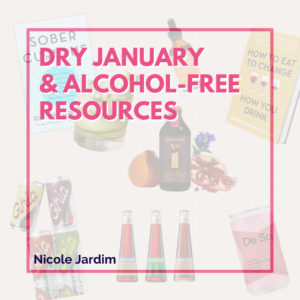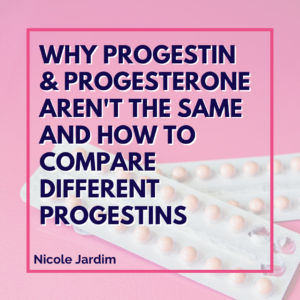A few weeks ago I was at a conference hosted by The Society for Menstrual Cycle Research. Uh huh, there is indeed a group of people who only research periods and hormones. I happen to think it’s soooo cool. Haha!
While there, I checked out a presentation on PMS and PMDD by Sally King of Menstrual Matters, and was surprised (and simultaneously not so surprised), to hear her share that in 2019, PMS is now defined in this way…
“PMS encompasses a vast array of psychological symptoms such as depression, anxiety, irritability, loss of confidence and mood swings. There are also physical symptoms, typically bloatedness and mastalgia.” [1]
Say what??
So PMS is now primarily a psychological condition? Hmmm….well, that certainly makes it easier to be treated with pharmaceuticals (birth control pills and antidepressants) doesn’t it? And even maybe make women feel like they are losing their minds, and need to be medicated?
What is PMS really?
I don’t buy this new definition of PMS at all. I still believe that PMS refers to a collection of primarily physical symptoms accompanied by a few mental and emotional symptoms that arise in a cyclical pattern, and usually coincide with the latter half of the menstrual cycle (luteal phase). The symptoms usually resolve when menstruation starts.
I say usually coincides, because for some women, the symptoms are more erratic or even occur during the first half of the cycle. Honestly though, I think there is something else going on for these women – like some kind of underlying condition that’s causing symptoms, but isn’t necessarily linked to cyclical hormonal fluctuations.
Many women are surprised to hear that PMS is even considered a legit condition at all. In our culture, it’s just part of the experience of being a woman, lame PMS jokes and all.
In fact, in her presentation, Sally even suggested that we should begin referring to it as “menstrual cycle related symptoms”, rather than the potentially harmful and misleading PMS.
PMS jokes aside, it’s important for you to know that you actually have much more control over this than you might believe. In actuality, what underlies all of the symptoms associated with PMS is hormonal imbalance, and the two main hormones involved are estrogen and progesterone, the key female sex hormones.
In addition to regulating the reproductive system, these hormones also heavily influence chemicals in the brain, including serotonin, dopamine, and oxytocin, which all affect mood and even gastrointestinal health.
What are the symptoms of PMS?
This is why there are so many PMS symptoms – around 150 actually. Women with PMS may present with one or more of the following symptoms:
- Bloating
- Cramping
- Acne
- Change in appetite
- Stomach upset, nausea or vomiting
- Sleep problems
- Headaches and menstrual migraines
- Breast tenderness or pain
- Low libido
- Fatigue
- Anxiety and irritability
- Depression
- Brain fog
As you can see, most of these are physical, which is why I DO NOT buy this updated definition of PMS being a psychological condition. I’ve also fixed my own PMS using something other than pharmaceuticals, so I know a thing or two about solutions…keep reading for all that 😉
What about PMDD?
For many women, PMS is just a normal inconvenience of menstruation but for 3%-8% of women, these symptoms can become so severe that they interfere with their daily activities. We call this PMDD, or premenstrual dysphoric disorder. This condition has the same symptoms as PMS but they are much more extreme.
Symptoms of PMDD:
- Decreased interest in usual activities
- Difficulty concentrating
- Sadness, hopelessness, or feelings of worthlessness
- Insomnia
- Excessive sleeping
- Irritability and anger that may cause increased conflict in relationships
- Feelings of being overwhelmed or out of control
- Feeling constant tension
- Depression
- Extreme Anxiety
Women with PMDD will often say how their menstrual cycles are negatively impacting their relationships, career and mental wellbeing. For these women, this is not just a matter of some uncomfortable cramps each month, but is more comparable to debilitating and sometimes traumatic symptoms.
Can you guess what the most common treatment is for PMDD?
If you guessed SSRIs (antidepressants), you were right. Oral contraceptives are also popular because they disrupt ovulation and the production of estrogen and progesterone – the evil PMS hormones. What this reinforces is the myth that a woman’s body cannot function normally without the use of medication. And this is just not true.
How can I cure my PMS/PMDD naturally?
Sadly, many women who suffer from PMS and PMDD have tried for years to get help from doctors only to be dismissed or told that their symptoms are normal or, in many cases prescribed anti-depressants to deal with their “psychosis”.
There is nothing normal about what women endure each month nor is it some female psychological disorder. For instance, PMDD is so often confused with depression, but they aren’t the same thing. Depression is an ongoing condition, whereas the emotional symptoms of PMDD are linked to the menstrual cycle, and fluctuate throughout the month depending on where a woman is in her cycle.
Hormonal imbalance and PMS
Ultimately, the issue lies in the delicate balance of estrogen and progesterone in the body and while there can be many causes for this imbalance, most of them have straightforward solutions that can literally change your life. Here are some of the culprits that can lead to an imbalance between estrogen and progesterone.
Causes of estrogen/progesterone imbalance:
- Psychological stress
- Diet
- Environmental toxins, especially the ones that mimic estrogen
- Poor detoxification
In this post I want to focus on stress and diet…I explain why next.
What do stress and diet have in common??
Well, they both set us up for unstable blood sugar. And, chronic blood sugar spikes and crashes are no bueno for your hormones. I believe it is massively important, and becoming an ever-present problem in our refined carbohydrate and stress filled world. In fact, when I got my diet and stress under control, my blood sugar followed suit and my PMS symptoms virtually disappeared.
This is why my Fix Your Blood Sugar Protocol the first step I recommend that women take to address their hormonal imbalance.
Wait, is PMS the same as being hangry?!
When you think of the symptoms of blood sugar instability or hypoglycemia and the symptoms of PMS, don’t you think they seem similar? Well, that’s because they are.
Evidence suggests that insulin sensitivity is higher in the follicular phase, and decreases in the luteal phase of the menstrual cycle.[2] This means that our bodies are more prone to blood sugar and insulin imbalances in the second half of our cycle, and the symptoms that accompany those issues. These include PMS cravings, mood swings, brain fog and bouts of fatigue.
This all happens because it is believed that estrogen enhances the efficiency of insulin. In the first half of the cycle when estrogen is high this will help keep blood sugar and insulin stable. On the other hand, progesterone can impair insulin sensitivity. [3,4]
In the second half of the cycle, too much or too little progesterone can affect blood sugar regulation. I know, this is so annoying. But basically all it means is there is a goldilocks amount of progesterone that is probably going to be a little different for each woman, based on her individual circumstances.
Additionally, insulin resistance raises the activity of an enzyme called aromatase, which is responsible for estrogen production. This means that high levels of insulin essentially raise estrogen, which sets the stage for estrogen dominance. As I said before, an imbalance between estrogen and progesterone is a culprit behind the physical and emotional symptoms of PMS and PMDD.
Okay, how do you know if your blood sugar is dysregulated or that you may have insulin resistance?
Some of the early signs and symptoms include:
- Brain fog and ongoing fatigue, as well as not feeling rested when waking up
- Increased belly fat
- Mid-morning or mid-afternoon energy dips or crashes
- Sleepiness after meals, and
- Sugar cravings, especially right after a meal
Do you experience one or more of these? If so, then you may have some blood sugar probs happening girlfriend.
How to test your blood sugar levels
One of the most important first steps to take on the hormone balancing journey is to test your blood sugar using a glucose testing meter. This is a great way to know for sure what your fasting blood sugar is and whether you are keeping your blood sugar balanced after meals.
Getting a blood sugar testing kit
You must purchase an inexpensive glucose meter, test strips and lancets in order to test your blood sugar levels. All can be purchased separately or in a test kit like the ones listed below.
The replacement strips can be pricey, so before you decide which meter to buy, check out the price of the strips.
Test kit options:
- Bayer Contour Complete Testing Kit – includes meter, 10 test strips and 10 lancets
- Bayer Contour Testing Kit – includes meter, 50 test strips and 50 lancets
- Easy Touch Testing Kit – includes meter, 100 test strips and 100 lancets
My Fix Your Blood Sugar Protocol has a detailed guide on how to use these tests and understand the results.
So, what should I do if you have a blood sugar imbalance?
#1 Eat a breakfast with protein and fat in it.
Bye bye bagel! Start your day with a whole foods meal that is packed with nutrients to fuel you through the morning. Don’t be afraid to eat foods that you might have at other meals for breakfast, especially veggies and most importantly leafy greens!
Here are some ideas:
- Superhuman Breakfast – Eggs (poached or soft-boiled), greens (steamed or sauteed, avocado, sweet potato, sauerkraut, & any other veggies you’d like
- Organic coconut yogurt and berries, with flax/chia seeds, or other nuts and seeds, coconut flakes etc.
- Breakfast burritos: Scrambled free range eggs, spinach or your favorite vegetables with GF tortillas. Try adding nitrate-free bacon or sausage.
- Vegetable frittata – use free range eggs and your favorite veggies (see my pinterest board for ideas)
- High fiber/high protein pancakes with berries and a sprinkle of cinnamon
#2 When eating, stop ALL the things.
What you eat is obviously important, but how you eat is equally or even more important. So how do you eat? When walking or rushing to work, standing up at the kitchen counter, at your desk while trying to get a million things done?
All of this raises your blood sugar because you’re eating in a stressed environment. So I want you to think about ways in which you can eat in a more calm environment. Make it your only priority.
- Can you go sit outside?
- Chewing and talking is not good for digestion, so can you be alone when you eat.
- Can you aim to chew your food 20-30 times per mouthful?
- How about if you set your table and make it really beautiful so it’s an experience rather than a chore?
It’s time to start thinking of eating as a meditative practice lady 🙂
#3 Make your vitamin D game strong!
More and more studies are finding a very strong link between Vitamin D deficiency and insulin resistance. In one study done in 2014, a direct correlation between low Vitamin D and diabetes was found when it was discovered that for every unit increase in vitamin D levels, there was an 8% decrease in the risk of getting diabetes. [5]
As you now know, blood sugar imbalance and insulin resistance are likely contributing to your PMS.
I highly recommend getting your Vitamin D levels tested. You can do this from home with this Vitamin D Test from Lets Get Checked. Be sure to use discount code Hormones20 to get 20% off the price of the test.
The optimal level of Vitamin D is kind of controversial because there are a wide range of accepted values. Conventional medicine has always found a very low level of vitamin D to be acceptable, somewhere between 12 and 30 ng/ml.
However, it is now known that these low levels are not enough for feeling optimal. From a functional medicine perspective, it is agreed that the minimum for vitamin D levels is 50 ng/ml. Some practitioners feel that 70ng/ml is optimal.
Always get vitamin D3 levels tested before beginning supplementation. If vitamin D levels are below 50, then get in the sunshine. Seriously, we can’t supplement our way out of a nature and sunshine deficiency people! 20-30 minutes a day with your arms and legs exposed should do the trick. Then you want to retest in about 3 months to see if the levels have risen.
Otherwise, I’d recommend working with a practitioner to determine the amount you should supplement with. The safe maintenance dose is 2000IU a day, but of course some people need much higher depending on their unique situation. The Vitamin D supplement I use and recommend to clients is Seeking Health Vitamin D3 + K2 Liquid and Capsules.
And there you have it – the one thing that could legitimately be causing your PMS and messing with your life! It’s high time you stop letting PMS and PMDD rule your world, which means it’s high time you reigned in your out of control blood sugar. You actually have so much more control over this problem, and don’t have to be medicated to feel like a sane person the week before your period. If you want a more in-depth approach for using food, lifestyle and supplements, to balance your blood sugar for good, grab my Fix Your Blood Sugar Protocol for just $47!
References:
- https://www.rcog.org.uk/en/guidelines-research-services/guidelines/gtg48/
- https://www.ncbi.nlm.nih.gov/pubmed/10071420
- https://www.ncbi.nlm.nih.gov/pubmed/20071559
- https://www.ncbi.nlm.nih.gov/pmc/articles/PMC2999972/
- https://www.sciencedaily.com/releases/2014/06/140623092052.htm




11 thoughts on “How to Fix Your PMS”
Nicole, you have covered 2-3 very important points about PMS in this post. Also, the tips you have shared about the diet & eating habits are totally on point. And, not to miss, Vitamin D! 100% works!
Great Article!
Been a fan of yours after hearing you on several podcasts throughout year. Thank you for addressing women’s health beyond simply child bearing. I have learned so much from your posts, podcasts, and interviews.
I have PMS that I’m working to fix, and I have recently found that the only thing to help the terriblecramps besides popping several Aleve is apple cider vinegar. A swallow or so every 2-4 hours is just as effective as NSAIDs and more effective than Tylenol. Why in the world would this work?
Hi Nicole, months ago my blood panel showed I had really low vitamin d levels so I started supplementing with 4000IU/daily. I’ve been getting sunshine & have continued with the 4000IU, my blood panel now shows i’m in a good range. Do you see any problems with continuing such a level of supplementation? I’m not aware of any negative side effects if one was to technically overdose? Thank you for your wonderful article <3
Hi Amy, you’re welcome! Unfortunately, I can’t make recommendations on supplements for liability reasons on the blog. I do always say that there can be too much of a good thing, and one should not supplement if one is not deficient. Once people get up to the health range for vitamin D, they can usually taper their supplementation. However, I’d work with a doctor or other health professional to make sure that you aren’t over-supplementing. xoxo
Hi Nicole,
This was extremely helpful. Since I had my son I stopped tracking my period a year ago possibly because I’ve felt good for most of the year. I’m very cautious about what I eat. In the past I was diagnosed with Bioolar 1 and I’ve always felt that I’ had PMDD I don’t take any Meds I eat well and exercise. But this month I couldn’t function for about 10 days before my period. This year since having my son I felt fine I got back in shape quickly. Last month I had alcohol which I haven’t had in close to 2 years! I’m not sure if that triggered the PMDD symptoms , I’ve been down for 2 weeks straight and I automatically thought of you 🙂 because I wasn’t tracking my period I couldn’t pin point what was happening, after that alcohol it seems I got this major sugar craze for 2 weeks I felt lethargic etc etc. Just today my period came and I feel like myself again. Do you think the alcohol contributes to this ??
Thank you 🙂 I will forward this to my clients great blog!
Hi Sylvia, thanks for your comment and I am SO sorry to hear you are going through this stuff! I totally think the alcohol could be a contributing factor, especially since you haven’t had it in a long time, but I think it’s one of probably a number of factors contributing to your symptoms. It’s so crucial to get blood sugar, gut health and liver function working optimally in order to feel stable throughout the month. I give you specific ways to do this in my Fix Your Period Program (Track 1). You can check it out here: https://nicolejardim.com/programs
Hope you’re feeling better. xo
This is spot on. Thanks for putting it in writing. I found out the long and hard way and hope the next person in need takes this blog post very seriously 🙂 Been there done that.
How about when you drastically change your diet aka going from a meat eater to vegan, how might that impact your menstrual cycle if before it was always on time every month?
Hi Emily!
I’ve found in my own experience and that of working with a number of women who are vegan or vegetarian, that they just aren’t getting enough protein or fat to 1) stabilize their blood sugar and 2) build sex hormones. So, the unstable blood sugar as a vegan can lead to period problems, and the lack of adequate protein and fat can lead to irregular ovulation which leads to more irregular periods. The brain prioritizes survival over ovulation and menstrual cycles every time, so if the brain senses that there is not enough protein or fat, or other nutrients to do basic bodily functions, it will funnel what its got into necessary functions and usually menstruation and fertility suffer.
Hope this is helpful! xoxo
Hi Nicole,
Great Article – simple solutions to a healthy menstrual cycle . Vitamin D Deficiency is a global phenomenon and my PMS virtually disappeared after I started supplementing with 2000 units a day
Thanks Ragini! Happy to hear that your PMS virtually disappeared after taking vitamin D 🙂